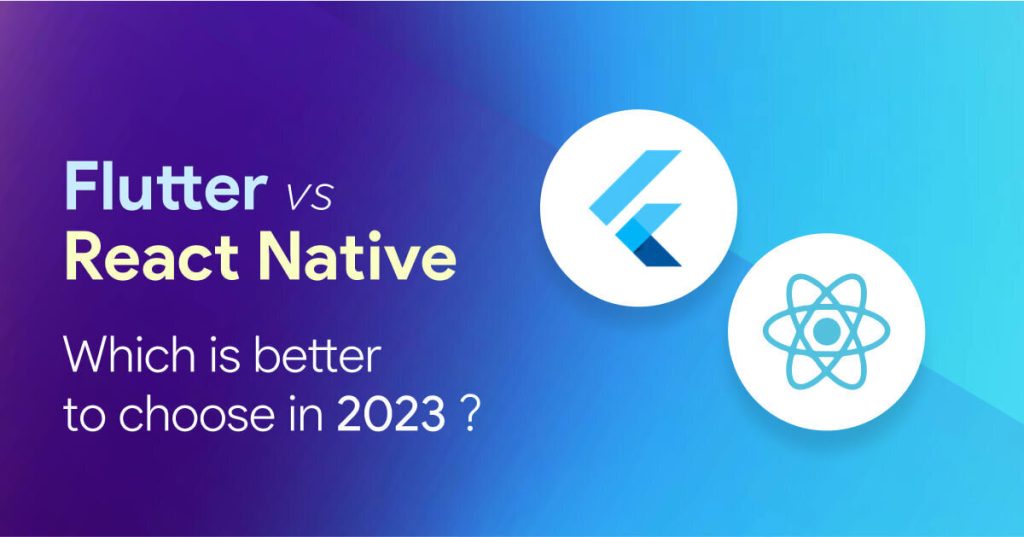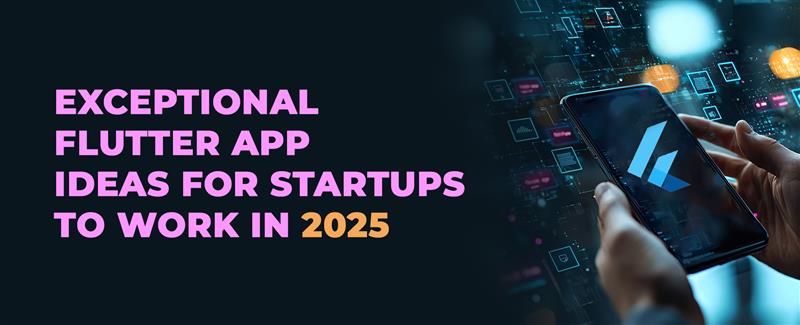Flutter vs React Native – Which is better to choose?
26 Dec 22 


The development of mobile apps has significantly accelerated the digitization phenomenon. All the products and services can be included in a single app with just a single click. The attractive user interface of these mobile applications enhances the customer experience by making everything readily available, from product purchases to inquiries. We will go into detail in this Flutter vs React Native comparison article to provide an answer to one of the most pressing concerns regarding app development’s potential for business expansion.
Because 92% of mobile users use mobile applications rather than web browsers, business owners should concentrate on mobile application development to ensure that they can attract customers through a variety of channels.
Flutter and React Native, whose popularity has steadily increased, will be the most popular cross-platform for app development in 2023.
Now the conflict is which one to choose for app development in 2023
Introduction
What is Flutter
Flutter is an open-source innovation for coding and making local applications for both Android and iOS. It was developed by Google and launched in the year 2018. This platform maintains visual consistency while combining ease of development with performance. The programming language “Dart” was initially intended to replace JavaScript in Flutter, an open-source and free platform. Organizations can develop an application using a single tool that can be used on the web, mobile, and desktop because Flutter makes it possible to create cross-platform applications with a single codebase. Flutter apps are a popular choice among Alibaba, eBay, and Google Assistant, all of which have complex framework requirements, due to their intuitive design and ease of use.
How does Flutter work?
A foundation library, widgets, and the Flutter engine are all part of the framework. Flutter’s declarative UI writing, in which you must start from the beginning, makes its approach to app development quite unique. Therefore, the user needs to have a clear understanding of the type of UI that will be created before beginning the development of any component. By combining various widgets, developers can create the entire user interface here. Additionally, developers can fuse custom widgets with existing ones with Flutter. Flutter also offers several software packages that give users access to the Redux and Firebase data storage to improve the user experience and increase application capabilities.
What is React Native?
React Native is a well-known mobile framework based on JavaScript that makes it possible to create natively rendered mobile applications for Android and iOS with the same codebase. In 2015, it was developed as an open-source project by Facebook. React-native has quickly become one of the most popular mobile app development solutions, with Instagram, Facebook, and Skype serving as well-known examples. It saves a lot of time and money because it only requires one line of code to be written.
How React Native works?
XML-like unique code is combined with JavaScript and JXL in React native. The ability to communicate with native app threads as well as JavaScript-based threads is provided by this framework. This cross-platform development solution runs on native ideas and components that already exist and does not render web views in its code. React-native facilitates bidirectional communication by establishing a connection between native and JavaScript lines.
Flutter vs React Native– Head-to-head comparison
Given are some of the most common influencing factors that every business considers while taking decisions:
Performance of the mobile : To execute source code in React Native, a connection must be made between the JavaScript code and the native environment of the device, enabling data and communication. The bridge converts JS code into the native programming language by acting as an interpreter. Sadly, this bridge is an additional agent in the chain that necessitates additional allocation of time and resources. Nearly, Ripple gathers to x86 and ARM local libraries without different layers. Consequently, less time and resources are needed to execute the code. Additionally, the cross-platform solution’s C++ graphic rendering engine makes Flutter’s animations quicker and more fluid. As a result, when it comes to mobile performance, Flutter outperforms React Native.
Performance of web : React Native rules the app development world. Along with C++ and HTML, JavaScript is one of the major front-end languages with excellent web performance. React Native is the best choice for your business if site performance is important to you because it provides technology that is made just for the app.
Graphics and designs: Flutter and React Native both platforms have excellent graphic capabilities, but their approaches to user interface design are distinct. A personalized, seamless user experience is made possible by React Native’s inheritance of native visual elements and appearance. To keep the app’s feel and similarity to other native applications intact even during operating system updates, the app elements will also update. Regardless of the operating system version or device model, the app will look the same in Flutter. Unless upgraded intentionally, navigation and other elements remain unchanged. Flutter makes it simpler to save project scope by implementing a standard neutral style for all devices.
Time to market : Time-to-market is an essential consideration when choosing between the two. In these Flutter vs React Native analysis says both of them are cross-platform solutions, it is possible to reuse code rather than writing separate apps.
Here are the crucial factors to consider when selecting the best application engineers for your app development:
- Communities of engineers for both platforms.
- Favorite among developers.
- Demand and price.
The older of the two platforms, React Native already has a larger community and produces enormous ready-to-use libraries and packages. Although Flutter is newer than React Native, Google engineers strongly endorse it. In this comparison of Flutter vs React Native, both platforms have experienced rapid growth in recent years, making them popular choices among programmers and engineers. React Native’s only drawback is that it requires connecting to third-party libraries to access additional features.
Demand and cost: Supply and demand are corelated. Since React Native’s framework is based on JavaScript, which many developers are already familiar with, finding the solution developer is simple. Even though Vacillate designers charge nearly less; it is precarious to find one at your area. It is more common among novice developers than experienced ones.
Support and reliability
Open-source platforms are distributed under permission-free licenses for both frameworks developed by the two largest tech companies in the world. When comparing Flutter and React Native, Flutter is relatively straightforward and resistant to operating system updates. However, in the event of system updates, React Native heavily relies on native components for additional adaptation efforts. Because it is a necessary compromise for the native app experience, this is not always regarded as a disadvantage of React Native.
App features and compatibility
On various Android and iOS devices, Flutter can display in a variety of resolutions. Advanced features may frequently necessitate native development for both Flutter and React Native. However, the composing part can address a few difficulties, at last, it prompts a decline in the support advantages of utilizing cross-stage arrangements. Through native code injections, widgets in Flutter and ready-made libraries in React Native enable near-native performance with complex features.
Mapping and geolocation
The Google group has given an assortment of Modules to Ripple. The applications’ tracking capabilities are enhanced by these plugins. Even though one-time tracking is fine with React Native, continuous monitoring can still cause problems that can only be resolved by writing components in the device’s native programming language.
Camera
When camera compatibility is compared between Flutter and React Native, Flutter’s use of the camera is flawless. There are issues with the device’s camera usage with React Native that necessitate more time and resource allocation to resolve and achieve the desired performance.
Flutter’s use of the camera was flawless. Some issues with the device’s camera usage with React Native necessitate more time and resource allocation to resolve and achieve the desired performance.
Streaming and video chat performance
For custom video chats in Flutter, you need an External plugin, and there are already a few ready-made paid solutions. This is possible to implement natively with React Native.
Analytics
Firebase, Google Analytics, and Adjust are just a few of the well-known analytics tools supported by both. React Native’s performance suffers when working on multiple analytics reports, whereas Flutter experienced no issues when using analytical tools.
Constant delivery
Flutter allows applications to be deployed using a command-line interface; however, CD for iOS apps require additional effort in this situation. React Native is compatible with several well-known third-party CI/CD services, including Fastlane, Gitlab CI/CD, GitHub Actions, and Microsoft AppCenter, despite the absence of an integrated tool or official documentation.
Safety features
To meet HIPAA regulations, both technologies can offer high levels of security for mobile applications. As a minimum set of measures, we recommend the following:
- The client side should store as little data as possible.
- Utilizing fewer third-party libraries is preferable.
- When a user exits the program or locks the screen, additional login verification should be required. Authentication tokens should expire.
- MFA entails using two or more stages to verify a user’s claimed identity from the information they know is stored on mobile client data.
Popularity
Flutter vs React Native , when tight competition prevails, Flutter has surpassed React Native as the most widely used cross-platform mobile framework by developers, according to a Statista survey. While in 2020, React Native had 42% of clients, it has diminished to 38% in 2021.
In terms of number of adoptions, React Native is currently the most popular platform. In this race, Flutter is catching up to React Native and is not far behind.
Market trends and technology evolution on Flutter vs React Native
Since last year, the number of people searching for Flutter has steadily increased, displacing React Native.
Latest React Native development:
- By moving optional elements to separate repositories, Lean Core can reduce app size.
- Turbo Modules – for better native module management.
- For re-architecting the user interface layer, use React native fabric.
Recent releases from Flutter:
- New widgets and features
- Improved SDKs for integrating Flutter into existing Android and iOS apps
- Web support in the Beta Channel.
- Changes to API
Flutter vs React Native-Pros and Cons
Flutter Pros
· Quick coding: Quick Coding gives developers quick access to applications with high performance.
· Hot reload: The developer can save time and increase productivity thanks to the platform’s real-time visibility of applied changes. Ripple’s hot reload gives an edge over contenders’ comparative highlights, permitting engineers to stop code execution, make changes to code, and keep coding from a similar spot, bringing about extraordinary speed.
· Widgets: One of the important qualities of flutter is how it uses the off the rack apps, securing compatible design and development. These widgets perform better than other open-source frameworks because they are based on Google’s code. A significant advantage is that many of them are customizable and adhere to both aesthetics and materials.
· Minimum coding: Dart, the coding language used in Flutter, is compiled directly into the ARM code of mobile phones, allowing applications to be launched more quickly. Through its native codebase and third-party integration, Flutter reduces developer stress.
· Appealing UI: The architecture of Flutter is intended to produce an attractive and individualized user interface. The creation of individualized apps with user-friendly and faster interfaces is its primary objective. It has enough power to allow designers to draw anything they can imagine.
· Bespoken Design: Skia, an open-source, high-performance graphic engine, is included in Flutter and is utilized by Adobe, Chrome, Amazon, and other major corporations. With this powerful tool, users can create custom applications that work equally well on Android and iOS devices. In addition, there is no longer a possibility of UI malfunctions during software updates.
· Same UI across platforms: Flutter’s business logic and user interface are identical across Android and Apple devices to ensure a consistent user experience. This feature is very important, especially for brands that have great corporate styles and are unique.
Flutter Cons
· Absence of third-party libraries: Third-party libraries have a significant impact on software development because they provide developers with additional features that are typically free, open-source, and have already been tested. Flutter is one of the newest mobile app development platforms on the market. As a result, it is still improving, so third-party libraries and packages are limited.
· Larger File Size: Another hard-to-miss Flutter drawback is the app’s larger file size. Each portable client on the planet needs more memory space. You may be forced to choose between an app, photos, or other files since many older devices cannot store additional apps. One of Flutter’s drawbacks is its small file size, which improves runtime and performance.
· Skill demand: Even though Flutter is a simple language, programmers must first master DART. Making the necessity of an extra period of learning, Flutter can build the time and cost of any undertaking.
React Native Pros
· Optimum performance: Using native modules and controls to improve performance is one way to assess a platform’s effectiveness. Utilizing distinct threads from native APIs and UIs in React Native results in performance enhancement and improvement. React Native interacts with native iOS and Android components and proceeds to generate native API codes independently of any interference.
· Live and hot reloading: Compiling and reading changes made by programmers is made easier with the live reloading feature. Additionally, it supplies the simulator with a brand-new file that immediately begins to read the application. Even if the developer does not recompile the application, hot reloading makes modifications to the source code viewable to him. After making changes to the code, developers can benefit from this feature of React Native, which reduces the amount of time spent waiting.
· Streamlined UI: The user interface in React native is straightforward and less complicated. In contrast to a conventional network, its architecture resembles an open-source one. To ensure that apps are created in the right order, this platform makes use of a software interface to remove unnecessary components. Apps developed with react native have a more seamless user experience, a responsive user interface, and load faster because they prioritize the user experience.
· Modular design: App developers can instantly upgrade or update apps thanks to a modular design and architecture. React Native’s user-friendly interface makes it possible for other developers to delve deeply into another developer’s project to build on it or make changes. Additionally, it takes less time for testers to comprehend program logic and construct appropriate test scenarios.
React Native Cons
· Consistency and debugging issues: React Native is still in beta, six years after its launch, which may come as a surprise. In addition, the debugging procedure is extremely time-consuming and complicated because React Native is built with JavaScript, C/C++, and Java. You must enable integration with Flipper, which provides a set of debugging tools, to resolve this issue.
· Complicated UI: React Native is not the best choice if you want to create a mobile application with a lot of transitions, animations, and interactions. Since the touch subsystems of Android and iOS do not share the same APIs and are quite distinct from one another, having a gesture responder will not help resolve the issue.
· Unfledged framework: Developers find it challenging to keep up with the latest developments in React Native app development. In its quest for speed, React Native lost its credibility and became too advanced for iOS and Android. When compared to native applications, even React Native apps lack flexibility.
· Difficult to develop a cross -platform team: The React Native team ought to be well-versed in both native technologies (CI, UX technologies) and web technologies (Java, React). It is trying to fabricate a group to address every one of the difficulties that emerge in creating cross-stage applications.
Flutter vs React Native who is the winner?
In comparison to React Native, Flutter performs better in terms of app compatibility, engineering, and future market trends. In comparison to React Native, Flutter performs better in terms of app compatibility, engineering cost, and future market trends. React Native, on the other hand, is superior when it comes to recruiting software developers. Time to market is directly influenced by the availability of skilled engineers. When choosing the appropriate app technology, this is crucial for many businesses.
Conclusion
There is no real winner between Flutter and React Native in terms of various parameters. The best framework to use is determined solely by your project’s parameters and business requirements because each project is unique.
Flutter is the best choice for apps that are larger and require native programming. For applications that can benefit from plug-and-play modules, React Native works well. Keep in mind that you must evaluate each application separately because each application is unique. It is always beneficial to discuss your project with an experienced team of developers: people who can think about a variety of approaches and have a wide range of skills that are sufficient for cross-platform development. If you ask a programmer who only knows one framework, you might get the wrong answer.
Flutter and React native are distinctive options for building mobile apps that have gained widespread popularity. With different approaches, each framework can help your application touch people’s hearts. Still confused on what exactly how to implement this application and performs your requirements, hire flutter developers or React Native developers from Mindster.
- Agentic AI1
- Android Development3
- Artificial Intelligence31
- Classified App3
- Custom App Development5
- Digital Transformation12
- Doctor Appointment Booking App14
- Dropshipping1
- Ecommerce Apps40
- Education Apps2
- Fintech-Apps37
- Fitness App4
- Flutter4
- Flutter Apps20
- Food Delivery App5
- Grocery App Development1
- Grocery Apps3
- Health Care10
- IoT2
- Loyalty Programs9
- Matrimony Apps1
- Microsoft1
- Mobile App Maintenance2
- Mobile Apps127
- Product Engineering6
- Progressive Web Apps1
- React Native Apps2
- Saas Application2
- Shopify9
- Software Development3
- Taxi Booking Apps7
- Truck Booking App5
- UI UX Design8
- Uncategorized6
- Web App Development1


















Comments